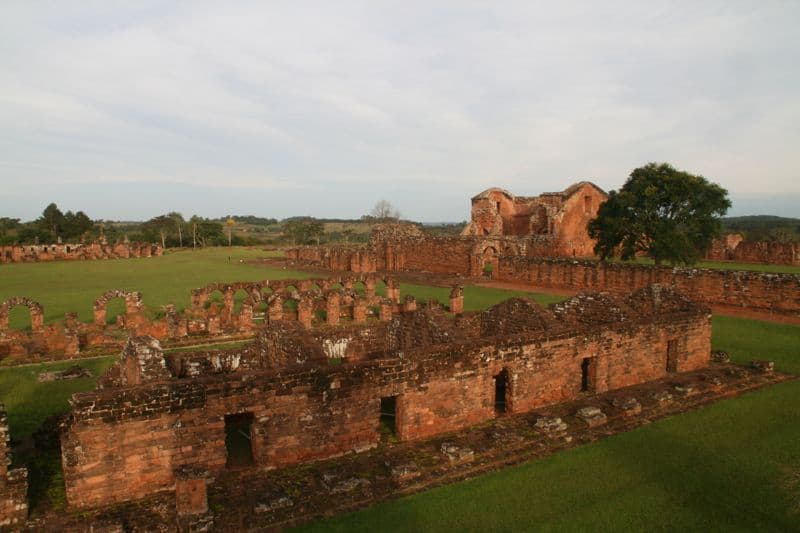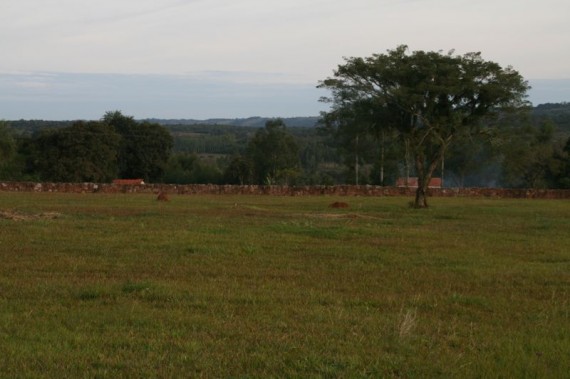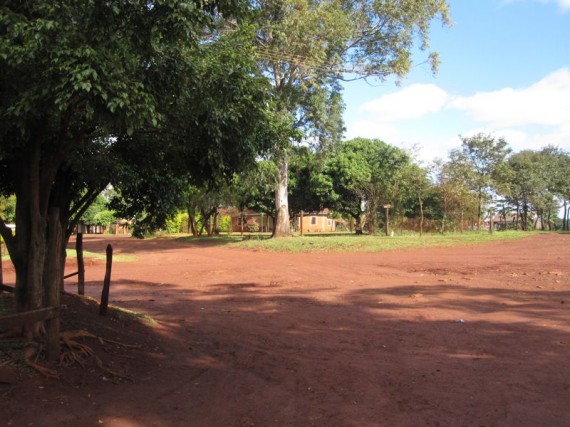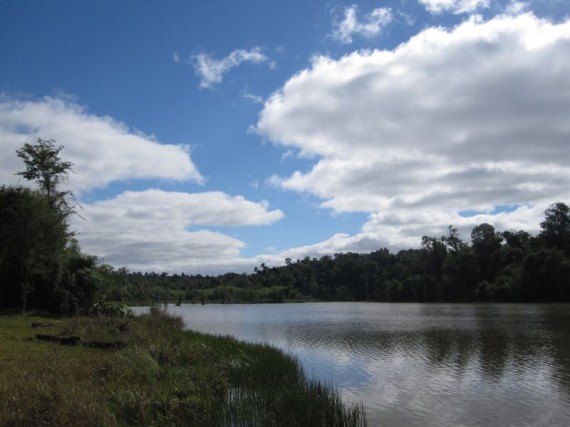This page contains affiliate links. Please read our disclosure for more info.
There’s no guidebook to Paraguay and we hadn’t met anyone who’d been there. No-one seemed to know much about this mysterious country in the centre of South America. This is why we wanted to visit – it seemed the ideal opportunity to get off the gringo trail and have that elusive “off the beaten track” experience. We didn’t regret our choice: we found a pretty, tranquil country with a crazy history, friendly people and no other tourists (well, we met three in three weeks). Our Spanish also benefited as no-one spoke English, and locals were curious about us so we had plenty of opportunities to practice.
Paraguay isn’t a place to visit for big name attractions – it’s a place for enjoying simple pleasures, appreciating the slow pace of life and trying to get under the skin of a different culture. That said, you will find UNESCO World Heritage sites, Jesuit ruins and museums, unspoilt countryside, a huge variety of colourful bird life, adventurous river trips and plenty of national parks for walks and wildlife-spotting.
Information is lacking about Paraguay so in this guide we aim to share practical details about our experiences.
Ciudad del Este
Many visitors to Paraguay only come for one day from Brazil or Argentina, crossing the border for cheap shopping or just a passport stamp. But this doesn’t count as visiting Paraguay – Ciudad del Este is vastly different from the rest of the country. Coming from Argentina it was a shock to the system. A ramshackle collection of stalls selling electronics and ‘designer’ clothes take over the pavements, forcing you to walk into the chaotic traffic. The colourful scene reminded us of the vibrant street life of India.
Our bus whizzed past without stopping at immigration at the border so we had to trek back and seek out our passport stamps (90 days for free for Brits). It’s not difficult to see how so much cheap produce gets here. Next to immigration is a helpful tourism desk who are keen to help – stock up on maps and information as there isn’t much around.
We weren’t fans of Ciudad del Este but to be fair we didn’t visit the two main attractions – both out of town – the Itaipú Dam and the Salto de Monday waterfall.
How to get here: We took the one hour bus trip from Puerto Iguazú (Argentina) but there are also regular buses from Foz do Iguaçu (Brazil). Both towns are the base to see the beautiful Iguazú Falls.
Where to stay: We found all the hotels listed in the Paraguay chapter of the Rough Guide and Lonely Planet South America guides to be surprisingly full. All the hotels seemed relatively expensive and we wished we had headed straight to Encarnacion. We ended up paying 150,000 Guarani (US $31) for the overpriced but fairly comfortable Hotel Caracol.
Where to eat: There aren’t many decent options in the centre of town, especially for vegetarians. We found a good place for lunch though: Gourangas is a Hare Krishna vegetarian restaurant behind the Municipalidad offering a choice of two meals each day. It isn’t very Indian but we enjoyed our tasty lentil soup and delicious pineapple juice with mint.
Encarnacion
Encarnacion is a relief after Ciudad del Este. It’s a quiet city that’s easy to wander around. Despite being Paraguay’s third biggest city it only has a population of 70,000. Expensive houses are found around the corner from old women sitting next to mounds of oranges on the side of the road shelling beans for sale.
It’s not a very exciting city but pleasant enough and a good base to visit the Jesuit ruins. There are quite a few options if you’re a history buff but we just visited Trinidad, one hour away on any bus back towards Ciudad del Este. They are obviously trying to promote tourism here as they are building a visitor centre, which would be useful as there is no other information about the site. We had the UNESCO World Heritage Site to ourselves though (except for a Mexican tourist who came along later) which is one of the attractions of the place.
We didn’t know much about what we were seeing, but the red ruins were atmospheric and the setting amongst the green, peaceful countryside is lovely. We enjoyed wandering around and climbing the bell tower as the sun began to set. Entry costs 25,000 G (US$5) and includes entry to the other Jesuit ruins Jesús and San Cosme, as well as the music and light show that takes place at Trinidad on Thursday – Sunday evenings.
How to get here: We took a taxi to Ciudad del Este bus station (the minimum charge of 20,000 G seemed expensive for the short trip) and got straight on a bus to Encarnacion (45,000 G). The ticket desks often try to sell you tickets for later buses even if there’s an earlier option. We found it was best to go to the platforms, ask for a bus to your destination and buy a ticket direct from the conductor – we never had to wait long this way. The five hour journey passes through pretty green countryside of rolling hills, simple wooden shacks and horse and carts. Entertainment is provided by the stream of vendors coming onto the bus to sell chipa (local cheese bread), drinks, fruit, socks, sunglasses, watches, DVDs, CDs, perfume and anything else you can think of.
Where to stay: Hotel Germano is right across from the bus station. It costs 100,000 G (US $20) for a double with private bathroom, 60,000 G with shared. The rooms are simple but decent and the owner is friendly. There is no wifi or breakfast.
Where to eat: Hiroshima Japanese restaurant (25 de Mayo and Lomas Valentinas) is considered to be very good although we only got to try a rather plain vegetable fried rice as vegetarian options are limited (we had to ask). They have fast wifi, as does ML Calentitas a café on the main square Plaza de Armas. The café also has heating (a blessing on cold winter nights), good breakfasts and cakes.
Parque Nacional San Rafael
One of the attractions of Paraguay is its large unspoilt areas of natural habitat, and in particular the huge variety of birds found here. Although we aren’t bird watchers we were keen to explore one of the country’s national parks. Many of them are difficult to access and the only accommodation option is camping, so we chose San Rafael as the environmental protection NGO Pro Cosara offers accommodation.
Reaching the park is part of the fun. A three hour rickety bus ride took us along red dirt roads into the depths of the Paraguayan countryside. It was Saturday morning and the bus was packed – the men kept up their spirits by making the driver stop at random wooden shacks where they picked up more beer (yes, at 9am). The mood was jovial as the beer guys told jokes in incomprehensible Guaraní (the indigenous language everyone speaks as well as Spanish).
Thankfully the conductor remembered to tell us when we reached Ynambú, and I realised why I hadn’t been able to find it on a map – it was just a collection of wooden shops in the middle of nowhere. We sat on the side of the road and waited, but after half an hour our lift hadn’t turned up. Luckily a friendly biologist who worked at one of the other NGOs in the park gave us a ride in the back of his truck along a bumpy dirt road into the forest.
Unsurprisingly we were the only people staying at Pro Cosara and we had the simple but attractive wooden guest building to ourselves. We hadn’t timed our trip very well as the Swiss owner Christine was away and the staff didn’t work on the weekends, so there was no-one to show us the trails. We also had quite rainy weather and cold nights. Despite this we enjoyed the peace of the farm on the edge of the forest and managed to wander around the easy trails on our own. We didn’t see much wildlife but it was pretty, blissfully peaceful and there’s a lovely lake to chill out by.
How to get here: The Empresa Pastoreo bus leaves from Encarnacion at 8am and 11.30am and takes three hours to get to Ynambú where you need to arrange for Pro Cosara to pick you up (transfers costs 30,000 G). Return buses leave at 1pm but bear in mind that the buses don’t run if it rains as the dirt roads become impassable.
Where to stay: Double rooms with shared bathroom cost 80,000 G (US$17) per person including all meals. You could save money by camping – tents are available to hire.
Where to eat: Meals are provided and the Paraguayan cook Aladia managed to cook us some great vegetarian meals, despite not eating vegetables herself! A highlight was freshly picked mushrooms from the forest.
Part 2 of our Paraguay Guide continues with our journey through Paraguay stopping off at small towns, the capital Asuncion and a tranquil farm near Concepcion.





Nice to read someone else has been here too, we are travelling west to east and currently in Encarnacion and heading to the falls. Nothing much seems to have changed since you visited 6 years ago, except for the prices have gone up a little.
Hi Erin,
I know it is 5 years since you posted this story, but I am going to Paraguay in December and may be you know how often bus goes from Cuidad del Este to Encarnacion and when the earliest one? Thanks.
I’m afraid I don’t know.
We hosted an exchange student from Paraguay for the last 6 month and she was a lovely girl. Now, my daughters are staying in Asuncion with her family for a month. Your blog is letting us see what they are seeing. Thanks!
Wonderful! That’s very cool and I’m sure it’ll be an amazing experience for your daughters.
I teach high school Spanish and your site is great for my kids when they do their travel project. It is different from the regular travel sites. Thanks so much.
Glad you enjoyed Paraguay, I’ve been living here for just over two years now – I recommend visiting, not just Encarnacion/Ciudad del Este – there is lots to do. Thankfully there is now a guidebook written by a Paraguay – Natalia’s website is here: / – I’ve bought the guidebook (available on Amazon) and recommend it, very informative especially about local culture.
If anybody is visiting and needs tips, contact me on Twitter @paraguayralph and I’ll point you in the right direction.
I love your post!
I’ve been staying in Ciudad del Este for 1 year, and the hotel Caracol is just nearby my store.
Obviously there’s not much information for doing a tour in this country. Even we don’t know where to go.
I visited Ruina Jesuita de Trinidad, but most of my friends have never been there, and they’re native, strainge isn’t it?
Thanks for the information about San Rafael, I’m planning to take a trip there.
Thanks Eric. It is amazing how few visitors the ruinas get. Enjoy San Rafael – it’s very peaceful.
im living near trinidad ruins over road number 6, i offer my house if someone want to visit trinidad ruins also jesus. I was living in tokyo for long, im really like this place. So i will be available for any questions..
Thanks for the offer Jorge.
Hi, Jorge, we are a couple from Hong Kong who is doing the backpacking around the world trip as well. We shall visit Trinidad and Jesus on March 14-15, would you mind if we can stay in your house for one evening, we like to share our chinese cooking and stories and also learn from your culture. We look forward to hear from you, please reply on email. Thank you.
Hello Jorge, its possible to visit all jesuit missions in one day?
Hi, I have been considering moving to a relative cheap place to live, and paraguay seems to be a good option. But there is not too much info around, wondered if you could help me?
Is there internet in the more urban areas?
How much is it to live in an urban area?
Are there any laws that allow them to cut your arms and legs off if you do something wrong? Like drive on wrong side of the road?
Thanks for this post as well, its helped me learn something so far…
From our experience there is internet in the urban areas. We stayed with a Peace Corp volunteer in a very small town San Juan, and it had really decent internet. I’m not sure about cost of living as we were just passing through and I imagine Asuncion is more expensive than other towns. We found it very reasonably priced generally.
I will be going by car from Montevideo to Posadas, Encarnacion, Asuncion, Juy Juy, Cordoba and Montevideo. What was the border crossings like? Where did you go after Paraguay? Where are you now?
We had no problem at the border at all. After Paraguay we went to Salta in Argentina (we really recommend the Cafayate area too). We spent a year in South America and are now in the UK on our way to Asia. Have a great trip – Paraguay is fascinating.
I recommend you to stay at san rafael hotel in Ciudad del Este ..in your next trip..to Paraguay..It´s in down town Av.Adrian Jara adn Abay..tel 595-61-500804 for reservations.
it´s clean..the people are friendly and open to help you and to give you information for all local attractions..like the Yguassu and Monday Water Falls National Park..and a visit to the Itaipu hydroelectric power plant..the biggest one in the whole world
Keep these Paraguay posts coming, I’m in Panama and taking the boat to South America on Tuesday so I’ll need them as reference guides!
Glad it will be useful! That’s exciting to take the boat from Panama – I look forward to hearing about it.
Great post! Definitely inspired me to consider taking a trip to Paraguay. Next summer I will be moving to Argentina and I am already looking to exploring the rest of South America as well.
Anyway, I enjoyed reading this post and I included it in our weekly roundup of blogs I enjoyed reading: . Feel free to share this back to your readers.
Cheers,
Andrew
—
Andrew Dunkle
Senior Editor
http://www.gooverseas.com
http://www.facebook.com/GoOverseas
twitter.com/GoOverseas
Email: [email protected]
Paraguay is so easy to get to from Argentina – just an hour from Iguazu Falls, so we would really recommend a visit. Thanks for including us in your post.
Hi, we are heading to Paraguay on July 28th for 2 weeks…keep up your blog I am following it….good pics!
Glad to hear someone else is going to Paraguay. Have a great trip!
I love Paraguay, the heart of South America!!
Bradt Travel Guides has a Paraguay guidebook. I’ve never read it, so can’t vouch for its usefulness. In the meantime, your post is a great start!
Oh yes – it’s just been released. I had heard it was being written. That’s good news!
I rather liked Ciudad del Este. The place had a rough charm to it. Mind you after Asuncion most places are an improvement. Overall I came away with a good impression of the country thanks to a taxi driver who twice returned 10 times the fare I mistakenly offered.
We found the people really friendly too, and weren’t that keen on Asuncion!
Hi there Erin,
Thank you for sharing! It was very difficult to find information on Paraguay! I am going to Asuncion and Ciudad Del Este in about 7 days. I also think we are crossing the border to Brazil and Argentina. I am very excited yet nervous at the same time! I have a few questions..
1. what is the culture, food, and history like?
2. how are the people?
3. what type of clothes should I bring?
4. did you get sick? were diseases an issue? I went to the doctor yesterday and told her I was going to Paraguay and she gave me like 4 shots! I am cognizant that Malaria is in both Asuncion and Ciudad Del Este! I am also aware that water is not potable.
If there is any extra information that you could give me that would be good to know.. Please feel free!
Thank you for your time! :)
Sincerely,
Syd
Seems like you guys are well placed to write the guide book on Paraguay! Maybe you should be on a retainer from one of the guide book companies. Sounds like there are quite a few tranquil spots free from hustle and bustle.
We actually heard of two people in Paraguay who are writing guidebooks so hopefully there should be one soon. It is definitely a chilled out country.